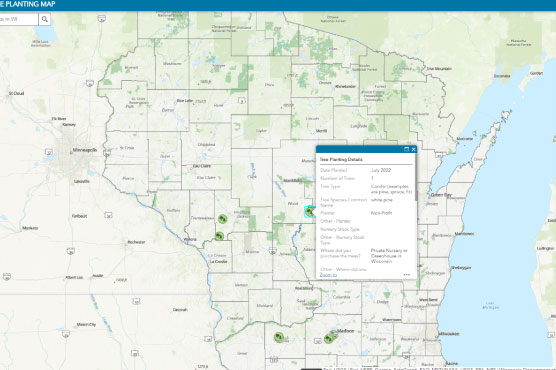Trillion Trees Pledge
The State of Wisconsin recognizes that healthy forests are one of the best nature-based solutions to climate change and joins a wide variety of corporations, governments and non-profit organizations in the US Chapter of the global Trillion Trees Initiative [exit DNR], led by the World Economic Forum and American Forests.
On Earth Day 2021, Governor Tony Evers signed Executive Order 112 pledging to protect and restore Wisconsin’s forestland by conserving 125,000 acres and planting 75 million trees by 2030. On Earth Day 2024, with over 32 million trees already planted, Governor Evers signed Executive Order 221 and announced that the state is increasing its Trillion Trees Pledge to 100 million trees by 2030.
The pledge includes providing wildlife habitat, supporting rural economies and equitable distribution of tree canopies in urban areas while continuing to support the responsible management of public and private forestland across Wisconsin. The Executive Order directs the DNR to implement the pledge [exit DNR] in partnership with public, private and non-governmental partners on behalf of the state of Wisconsin.
By 2030, the goals in Wisconsin are to:
- Conserve 125,000 acres of forestland
- Plant 99 million trees in rural areas
- Plant 1 million trees in urban areas
42,794,204
Trees planted in Wisconsin as of Dec. 31, 2024
Wisconsin Tree Planting Map
Put your newly planted trees on the map! This short survey will let you count the trees you've planted as part of Wisconsin's pledge toward the Trillion Trees Initiative. Just answer a few questions on the type and number of trees planted, mark their locations on the map and see the progress you've made toward moving Wisconsin closer to its pledged goal.
Background
Wisconsin has a more than century-long history of planting trees – the DNR's Reforestation Program has supplied Wisconsin landowners with over 1.6 billion seedlings since 1911. There was a record high of more than 44 million seedlings planted in 1959. Tree planting then declined for several reasons, with fewer than 3 million seedlings being planted in 2019 across the state for reforestation purposes.
Wisconsin’s Trillion Trees Pledge renews a commitment by the state to manage our public lands, work with private landowners and engage with organizations across Wisconsin to sustain and grow the benefits that forests offer. Forest products contribute $24.2 billion annually to the state’s economy, and this planting effort will help ensure that Wisconsin forest industries have the source materials well into the future.
The Wisconsin pledge will address tree equity. In most U.S. cities, the distribution of urban tree canopy often disproportionately benefits high-income neighborhoods. Research has found that trees offer many positive attributes to urban residents, improving air quality and public health, reducing heat and heat illnesses, lowering utility bills, improving water quality and reducing flooding and stormwater runoff. Urban tree planting combined with enhanced tree maintenance can substantially increase urban forest carbon storage and deliver additional benefits through energy savings, especially if tree planting programs are targeted to urban heat islands.
In addition to safeguarding water resources, providing wildlife habitat and supporting rural economies, maintaining healthy forests is also essential to mitigating climate change. These healthy forests store carbon as well as provide the source material for the many forest products we depend on daily. Long-term durable wood products, like building materials and furniture, help mitigate climate change as the forest carbon continues to be stored after the timber is harvested. Recognizing this, Gov. Evers’ Task Force on Climate Change recommended forest management as a critical state strategy for mitigating climate change. Learn more on our Forestry and the Wisconsin Economy page.
The annual reports provide more details on our progress toward our pledge:
Get Involved
So how is all this going to happen? We need your help. How can we support your efforts in the state? Is there a project we can collaborate on to achieve multiple outcomes? We have already begun discussions with some entities and look forward to discussing what role we can all play in this pledge.
For more information, contact DNR Trillion Trees Program Coordinator Bobbie Webster at Bobbie.Webster@wisconsin.gov.
Partners
- Wisconsin Department of Natural Resources
- Wisconsin Department of Administration [exit DNR]
- Wisconsin Department of Transportation [exit DNR]
- Wisconsin Department of Agriculture, Trade and Consumer Protection [exit DNR]
- Wisconsin Economic Development Corporation [exit DNR]
- Board of Commissioners of Public Lands [exit DNR]
- UW System [exit DNR] & WI Technical College System [exit DNR]
- Wisconsin County Forests Association [exit DNR]

